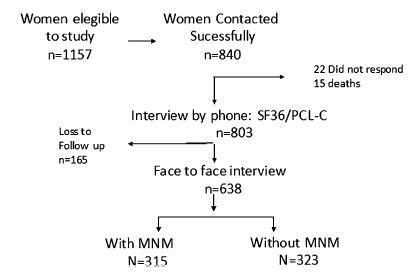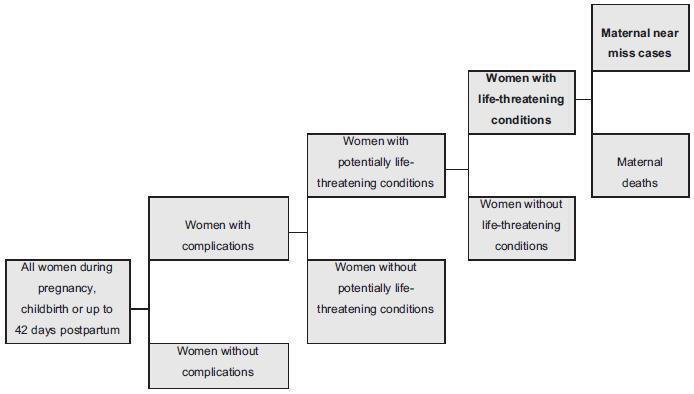-
Original Articles
Risks of Maternal Obesity in Pregnancy: A Case-control Study in a Portuguese Obstetrical Population
Revista Brasileira de Ginecologia e Obstetrícia. 2019;41(12):682-687
02-03-2019
Summary
Original ArticlesRisks of Maternal Obesity in Pregnancy: A Case-control Study in a Portuguese Obstetrical Population
Revista Brasileira de Ginecologia e Obstetrícia. 2019;41(12):682-687
02-03-2019Views147See moreAbstract
Objective
The present study aims to understand to what extent obesity is related to adversematernal, obstetrical, and neonatal outcomes in a Portuguese obstetrical population.
Methods
A retrospective case-control study was conducted at the Department of Obstetrics of a differentiated perinatal care facility. The study compared 1,183 obese pregnant womenwith 5,399 normal or underweight pregnantwomen for the occurrence of gestational diabetes, hypertensive pregnancy disorders, and preterm birth. Mode of delivery, birthweight, and neonatal intensive care unit (ICU) admissionswere also evaluated. Mean blood glucose values were evaluated and compared between groups, in the first and second trimesters of pregnancy. Only singleton pregnancies were considered.
Results
The prevalence of obesity was 13.6%. Obese pregnant women were significantly more likely to have cesarean sections (adjusted odds ratio [aOR] 2.0, p< 0.001), gestational diabetes (aOR 2.14, p< 0.001), hypertensive pregnancy disorders (aOR 3.43, p< 0.001), and large-for-gestational age ormacrosomic infants (aOR 2.13, p< 0.001), and less likely to have small-for-gestational age newborns (aOR 0.51, p< 0.009). No significant differences were found in terms of pretermbirths, fetal/neonatal deaths, low birthweight newborns, and neonatal ICU admissions among cases and controls. Maternal obesity was significantly associated with higher mean blood glucose levels, in the first and second trimesters of pregnancy.
Conclusion
Obesity is associated with increased risks of adverse pregnancy and neonatal outcomes. These risks seem to increase progressively with increasing body mass index (BMI) class. Female obesity should be considered a major public health issue and has consequences on maternal-fetal health.
-
Original Articles
Comparison of Maternal and Fetal Outcomes in Parturients With and Without a Diagnosis of Gestational Diabetes
Revista Brasileira de Ginecologia e Obstetrícia. 2019;41(11):647-653
12-20-2019
Summary
Original ArticlesComparison of Maternal and Fetal Outcomes in Parturients With and Without a Diagnosis of Gestational Diabetes
Revista Brasileira de Ginecologia e Obstetrícia. 2019;41(11):647-653
12-20-2019Views140See moreAbstract
Objective
The present study aims to compare the maternal and fetal outcomes of parturients with and without a gestational diabetes diagnosis.
Methods
A case-control study including parturients with (cases) and without (control) a gestational diabetes diagnosis, who delivered at a teaching hospital in Southern Brazil, between May and August 2018. Primary and secondary data were used. Bivariate analysis and a backward conditionalmultivariate logistic regression were used to make comparisons between cases and controls, which were expressed by odds ratio (OR), with a 95% confidence interval (95%CI) and a statistical significance level of 5%.
Results
The cases (n=47) weremore likely to be 35 years old or older compared with the controls (n=93) (p<0.001). The cases had 2.56 times greater chance of being overweight (p=0.014), and a 2.57 times greater chance of having a positive family history of diabetes mellitus (p=0.01). There was no significant difference regarding weight gain, presence of a previous history of gestational diabetes, height, or delivery route. The mean weight at birth was significantly higher in the infants of mothers diagnosed with diabetes (p=0.01). There was a 4.7 times greater chance of macrosomia (p<0.001) and a 5.4 times greater chance of neonatal hypoglycemia (p=0.01) in the infants of mothers with gestational diabetes.
Conclusion
Therefore, maternal age, family history of type 2 diabetes, obesity and pregestational overweightness are important associated factors for a higher chance of developing gestational diabetes.
-
Original Articles
Drug Use during Pregnancy and its Consequences: A Nested Case Control Study on Severe Maternal Morbidity
Revista Brasileira de Ginecologia e Obstetrícia. 2018;40(9):518-526
09-01-2018
Summary
Original ArticlesDrug Use during Pregnancy and its Consequences: A Nested Case Control Study on Severe Maternal Morbidity
Revista Brasileira de Ginecologia e Obstetrícia. 2018;40(9):518-526
09-01-2018Views202See moreAbstract
Objective
To assess the relationship between the use of psychoactive substances during pregnancy and the occurrence of severe maternal morbidity (SMM), perinatal outcomes and repercussions on the neuropsychomotor development of exposed children.
Methods
A case-control study nested within a cohort of severe maternal morbidity (COMMAG) was performed. Women with SMM were considered cases. Controls were thosewith low-risk pregnancy,without SMMand admitted during the same time period as the cases. Cohort data were collected retrospectively in hospital records for childbirth. A face-to-face interview was also performed with 638 women (323 without SMM and 315 with SMM) and their children of the index pregnancy between 6 months and 5 years after childbirth. During the interview, substance abuse during pregnancy was assessed by a modified question from the Alcohol, Smoking and Substance Involvement Screening Test 2.0 (ASSIST) and the neuropsychomotor development in the children was assessed by the Denver Developmental Screening Test, 2nd edition.
Results
The prevalence of licit or illicit drug use during pregnancy was ~ 17%. Among drug users, 63.9% used alcohol, 58.3% used tobacco, 9.2% used cocaine/crack and 4.6% used marijuana. There was no association between drug use during pregnancy and SMM, although tobacco use during pregnancy was associated with bleeding, presence of near-miss clinical criteria (NMCC) and alteration in infant development; alcohol use was associated with neonatal asphyxia; and cocaine/crack use was associated with the occurrence of some clinical complications during pregnancy.
Conclusion
The use of psychoactive substances during pregnancy is frequent and associated with worse maternal, perinatal and child development outcomes.

-
Review Article
Multiple Pregnancy: Epidemiology and Association with Maternal and Perinatal Morbidity
Revista Brasileira de Ginecologia e Obstetrícia. 2018;40(9):554-562
09-01-2018
Summary
Review ArticleMultiple Pregnancy: Epidemiology and Association with Maternal and Perinatal Morbidity
Revista Brasileira de Ginecologia e Obstetrícia. 2018;40(9):554-562
09-01-2018Views274See moreAbstract
Twin pregnancy accounts for 2 to 4% of total births, with a prevalence ranging from 0.9 to 2.4% in Brazil. It is associated with worse maternal and perinatal outcomes. Many conditions, such as severe maternal morbidity (SMM) (potentially life-threatening conditions and maternal near-miss) and neonatal near-miss (NNM) still have not been properly investigated in the literature. The difficulty in determining the conditions associated with twin pregnancy probably lies in its relatively low occurrence and the need for larger population studies. The use of the whole population and of databases from large multicenter studies, therefore, may provide unprecedented results. Since it is a rare condition, it ismore easily evaluated using vital statistics from birth e-registries. Therefore, we have performed a literature review to identify the characteristics of twin pregnancy in Brazil and worldwide. Twin pregnancy has consistently been associated with SMM, maternal near-miss (MNM) and perinatal morbidity, with still worse results for the second twin, possibly due to some characteristics of the delivery, including safety and availability of appropriate obstetric care to women at a high risk of perinatal complications.

-
Review Article
Preeclampsia
Revista Brasileira de Ginecologia e Obstetrícia. 2017;39(9):496-512
09-01-2017
Summary
Review ArticlePreeclampsia
Revista Brasileira de Ginecologia e Obstetrícia. 2017;39(9):496-512
09-01-2017Views346Abstract
The authors review hypertensive disease during pregnancy with an academic and practical view, and using the best evidence available. This disease, which is the most important clinical disease in Brazilian pregnant women, may have its incidence reduced with prevention through the use of calcium and aspirin in pregnant women at risk. Previously, it was a disease that presented with hypertension with proteinuria, but it has now been classified with new clinical parameters besides proteinuria. Morbidity and mortality should be reduced in a continental country such as Brazil using protocols for the early treatment of complications by calculating severe outcomes in preeclampsia. The early treatment of acute hypertension, use of magnesium sulfate and early hospitalization in cases of preeclampsia are concepts to pursue the reduction of our pregnant women’s mortality.
Key-words HELLP syndromeHigh risk pregnancyPreeclampsiapregnancy arterial hypertensionPregnancy complicationsSee more
-
Artigos Originais
Factors associated with low birth weight among adolescents in the Brazil Southeast region
Revista Brasileira de Ginecologia e Obstetrícia. 2011;33(10):286-291
01-06-2011
Summary
Artigos OriginaisFactors associated with low birth weight among adolescents in the Brazil Southeast region
Revista Brasileira de Ginecologia e Obstetrícia. 2011;33(10):286-291
01-06-2011DOI 10.1590/S0100-72032011001000003
Views77PURPOSES: To determine the rate of low birth weight and some of the risk factors associated with this event among adolescents. METHODS: A cross-sectional study conducted between October 1994 and December 2009 at a maternity in Campinas, in Brazil, using information generated from the computerized obstetric form. After selection of adolescents who delivered at this hospital, two groups were created, with and without low birth weight, respectively. Relative risk and 95% confidence interval for all independent variables (risk factors) and the Χ2 test for some perinatal results were performed. The level of significance was set at 5%. RESULTS: During the study period, 24,000 births occurred at CAISM. Of these, 2,404 occurred among 2,357 teenagers (10.02%) and the frequency of low birth weight was 15.1%. Adolescent pregnancy recurred in 294 (8.2%). Age less than 15 years-old, anemia, smoking, and hypertension were not significantly associated with low birth weight. Antecedent of miscarriage and association with systemic lupus erythematosus increased the risk of low birth weight. Cesarean section and an Apgar score below seven were more prevalent among adolescents with low birth weight, and 85% of all adolescents had less than six prenatal visits. CONCLUSIONS: The prevalence of low birth weight is higher among adolescents than among adult women, and there was a large number of adolescents with less than six prenatal visits . The antecedent of miscarriage and the presence of systemic lupus erythematosus were risk factors associated with the occurrence of low birth weight among adolescents.
Key-words AbortionHigh risk pregnancyInfantLow birth weightLupus erythematosusPregnancy in adolescenceprematurePrenatal careRisk factorssystemicSee more -
Trabalhos Originais
Impact of Advanced Maternal Age on the Outcome of Pregnancy
Revista Brasileira de Ginecologia e Obstetrícia. 1998;20(7):389-394
04-09-1998
Summary
Trabalhos OriginaisImpact of Advanced Maternal Age on the Outcome of Pregnancy
Revista Brasileira de Ginecologia e Obstetrícia. 1998;20(7):389-394
04-09-1998DOI 10.1590/S0100-72031998000700004
Views76See moreMost authors agree on the negative impact of pregnancy in women with advanced maternal age on maternal and perinatal outcome. However, it is not usual to evaluate if some considered risk factors are only confounders because they are present in women over forty years. In order to identify the isolated effect of age on maternal and perinatal outcome of pregnancies in women over forty, 494 pregnancies from this age group were compared to 988 pregnancies among women aged 20 to 29 years, matched by parity. After controlling possible confounding variables through multivariate analysis, advanced maternal age maintained its association with a higher prevalence of hypertension, malpresentation, cesarean section, postpartum hemorrhage, low Apgar score, perinatal death, late fetal death and intrapartum fetal distress. These findings show the need for adequate obstetrical care with special attention to those factors in order to improve maternal and perinatal outcome of pregnancies in women with advanced age.
-
Trabalhos Originais
A randomized trial of misoprostol and placebo for cervical ripening and induction of labor
Revista Brasileira de Ginecologia e Obstetrícia. 1998;20(8):457-462
04-05-1998
Summary
Trabalhos OriginaisA randomized trial of misoprostol and placebo for cervical ripening and induction of labor
Revista Brasileira de Ginecologia e Obstetrícia. 1998;20(8):457-462
04-05-1998DOI 10.1590/S0100-72031998000800005
Views72See moreObjective: to determine the efficacy and safety of misoprostol for cervical ripening and induction of labor in pregnant women at term when compared with placebo. Patients and Methods: fifty-one high-risk pregnant women at term, with unripe cervix, were allocated in a double-blind trial for treatment with intravaginal misoprostol (40 mg, 4/4 h) or intravaginal placebo. Results: thirty-two patients received misoprostol and 19 received placebo. The groups were homogeneous concerning maternal age, gestacional age, parity, and indication for induction (p > 0.05). In the misoprostol group the efficacy was 87.5% and in the placebo group 21.1% (p = 0.0000087). Regarding delivery, in the misoprostol group 75% had vaginal delivery and 25% abdominal delivery, and in the placebo group only 32% had vaginal delivery and 68% abdominal delivery (p = 0.0059).The Apgar score was similar. Conclusion: in this study misoprostol was effective and safe for cervical ripening and induction of labor.


